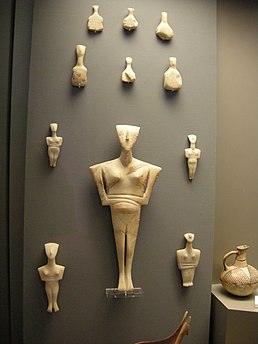Cycladic art
Pre-Greek artistic tradition / From Wikipedia, the free encyclopedia
Dear Wikiwand AI, let's keep it short by simply answering these key questions:
Can you list the top facts and stats about Cycladic art?
Summarize this article for a 10 years old
The ancient Cycladic culture flourished in the islands of the Aegean Sea from c. 3300 to 1100 BCE.[1] Along with the Minoan civilization and Mycenaean Greece, the Cycladic people are counted among the three major Aegean cultures. Cycladic art therefore comprises one of the three main branches of Aegean art.
| History of art |
|---|
|
Periods and movements |
The best known type of artwork that has survived is the marble figurine, most commonly a single full-length female figure with arms folded across the front. The type is known to archaeologists as a "FAF" for "folded-arm figure(ine)". Apart from a sharply-defined nose, the faces are a smooth blank, although there is evidence on some that they were originally painted. Considerable numbers of these are known, although most were removed illicitly from their unrecorded archaeological context, which seems usually to be a burial.
